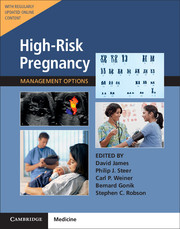Book contents
- Frontmatter
- Contents
- List of Contributors
- Preface
- Section 1 Prepregnancy Problems
- Section 2 Early Prenatal Problems
- Section 3 Late Prenatal – Fetal Problems
- Section 4 Problems Associated with Infection
- Section 5 Late Pregnancy – Maternal Problems
- Section 6 Late Prenatal – Obstetric Problems
- 52 Abdominal Pain in Pregnancy
- 53 Nonmalignant Gynecology in Pregnancy
- 54 Bleeding in Late Pregnancy
- 55 Multiple Pregnancy
- 56 Threatened and Actual Preterm Labor
- 57 Prelabor Rupture of the Membranes
- 58 Breech Presentation, Unstable Lie, Malpresentation, and Malpositions
- 59 Prolonged Pregnancy
- 60 Induction of Labor and Termination of the Previable Pregnancy
- 61 Dysfunctional Labor
- 62 Shoulder Dystocia
- 63 Fetal Compromise in Labor
- 64 Neuraxial Analgesia and Anesthesia in Obstetrics
- 65 Perineal Repair and Pelvic Floor Injury
- 66 Assisted Vaginal Delivery
- 67 Delivery After Previous Cesarean Section
- 68 Cesarean Section
- Section 7 Postnatal Problems
- Section 8 Normal Values
- Index
53 - Nonmalignant Gynecology in Pregnancy
from Section 6 - Late Prenatal – Obstetric Problems
- Frontmatter
- Contents
- List of Contributors
- Preface
- Section 1 Prepregnancy Problems
- Section 2 Early Prenatal Problems
- Section 3 Late Prenatal – Fetal Problems
- Section 4 Problems Associated with Infection
- Section 5 Late Pregnancy – Maternal Problems
- Section 6 Late Prenatal – Obstetric Problems
- 52 Abdominal Pain in Pregnancy
- 53 Nonmalignant Gynecology in Pregnancy
- 54 Bleeding in Late Pregnancy
- 55 Multiple Pregnancy
- 56 Threatened and Actual Preterm Labor
- 57 Prelabor Rupture of the Membranes
- 58 Breech Presentation, Unstable Lie, Malpresentation, and Malpositions
- 59 Prolonged Pregnancy
- 60 Induction of Labor and Termination of the Previable Pregnancy
- 61 Dysfunctional Labor
- 62 Shoulder Dystocia
- 63 Fetal Compromise in Labor
- 64 Neuraxial Analgesia and Anesthesia in Obstetrics
- 65 Perineal Repair and Pelvic Floor Injury
- 66 Assisted Vaginal Delivery
- 67 Delivery After Previous Cesarean Section
- 68 Cesarean Section
- Section 7 Postnatal Problems
- Section 8 Normal Values
- Index
Summary
Introduction
This chapter discusses the management of a number of gynecologic problems in association with pregnancy that are not covered elsewhere in the book.
The management of the following is discussed elsewhere:
• Malignant gynecologic problems: Chapter 48
• Infection: Chapters 23–29
• Female genital mutilation: Chapter 3
• Previous pelvic floor surgery: Chapter 65
• Previous third-degree tear: Chapter 65
Ovarian Cysts in Pregnancy
Introduction
Incidental detection of an ovarian cyst has become more common with the increasing availability of prenatal ultrasound scanning. In a retrospective audit, 4.8% of women having a scan before 10 weeks had an ovarian cyst of 3 cm or more. Larger ovarian cysts, _6 cm, are estimated to occur much less frequently, in 0.5–2 per 1000 pregnancies. Most unilocular and anechoic ovarian cysts with thin borders that are seen during the first trimester are corpus luteum cysts. These cysts do not usually persist beyond the end of the first trimester. Although the majority of ovarian cysts in pregnancy are asymptomatic, and resolve spontaneously, some can present with torsion or pain.
A review of incidentally detected ovarian cysts reported the following proportions:
• functional cysts: 20%
• serous cysts: 50%
• mucinous cysts: 10%
• dermoid cysts: 30%
In general, further evaluation and surgical management of cysts detected in early pregnancy is usually left until the second trimester.
Maternal and Fetal Risks
The major risks of ovarian cysts in pregnancy are to the mother, namely pain from torsion, rupture, or hemorrhage into the cyst. A large cyst late in pregnancy may predispose to malpresentation or obstructed labor. The overall rate of torsion is approximately 15%, with ovarian masses between 6 and 8 cm having almost twice the risk of torsion compared to other sizes. The majority of torsions tend to occur in the second trimester.
Most ovarian cysts are asymptomatic and resolve spontaneously, and ovarian carcinoma developing de novo during pregnancy is uncommon, with malignancy being found in approximately 1–6% of cases.
- Type
- Chapter
- Information
- High-Risk Pregnancy: Management OptionsFive-Year Institutional Subscription with Online Updates, pp. 1544 - 1556Publisher: Cambridge University PressFirst published in: 2017

